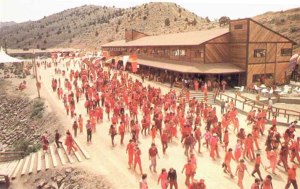 I recently saw a documentary film that chronicled the birth, then analyzed the reasons for the rapid death of this fascinating, idealistic community in Oregon’s spectacular high desert country. Through the film, I relived my exposure to the development of this grand endeavor. “In 1981, Bhagwan Shree Rajneesh, a spiritual leader from India, and thousands of his disciples, set out to build a new city, a utopian community in the desert . . . Thousands of people from around the world gathered here to celebrate life and transform the landscape. But by 1986, they were gone.” www.opb.org/television/programs/oregonexperience/segment/rajneeshpuram
I recently saw a documentary film that chronicled the birth, then analyzed the reasons for the rapid death of this fascinating, idealistic community in Oregon’s spectacular high desert country. Through the film, I relived my exposure to the development of this grand endeavor. “In 1981, Bhagwan Shree Rajneesh, a spiritual leader from India, and thousands of his disciples, set out to build a new city, a utopian community in the desert . . . Thousands of people from around the world gathered here to celebrate life and transform the landscape. But by 1986, they were gone.” www.opb.org/television/programs/oregonexperience/segment/rajneeshpuram
It was an accurate portrayal of the story, from my early knowledge of the Rajneeshees. I didn’t know many of the events of the last three years of their existence. My CPA firm had stopped providing services to them by then. We knew only the glory years, the glorious reclaiming of the land and building of the amazing city in the desert.
My firm was asked to provide audit services for their corporation. Although skeptical about this commune, after due diligence research we took them on as a client just as they moved to Oregon. I came to trust them; they wanted to disclose everything required by accounting reporting standards and more. They waived our professional confidentiality commitment to them; they wanted everyone to know more about them. They wanted to be trusted and respected by Oregonians.
Rajneeshee leaders hired the best service providers in Oregon – attorneys, engineers, environmental scientists, agriculture specialists and more – to help them build something wonderful and good. The Rajneeshees I met (former doctors, attorneys, accountants, religious, business owners, teachers, musicians), educated and smart, had one thing in common. They were searching for “truth”, their purpose in life, their reason for being.
The implosion was a classic example of leadership run amok. The adage “power corrupts” was true here; they soon became a divided leadership group. The structure of Rajneeshpuram, with absolute power at the top and few others involved in decision-making, enabled the tragedy.
Faced with legal and political challenges from outside and also with internal strife, top leaders became combative rather than collaborative. They chose confrontation over reason and compromise. They chose to protect their own personal positions, without regard for law, morality, or for the good of their own community. The Vision was corrupted.
For the full fascinating story see “Utopia and Bureaucracy: The Fall of Rajneeshpuram, Oregon” by Carl Abbott, Portland State University.
